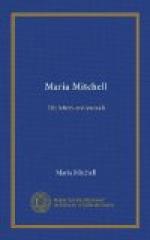“... We had a very good bit of missionary work done at our table (at Vassar) to-day. A man whom we all despise began to talk against voting by women. I felt almost inclined to pay him something for his remarks.
“A group from the Washington Women Suffrage Association stopped here to-day.... I liked Susan B. Anthony very much. She seemed much worn, but was all alive. She is eighteen months younger than I, but seems much more alert. I suppose brickbats are livelier than logarithms!”
Miss Mitchell was a member of several learned societies.
She was the first woman elected to membership of the
American Academy of
Arts and Sciences, whose headquarters are at Boston.
In 1869 she was chosen a member of the American Philosophical Society, a society founded by Benjamin Franklin, in Philadelphia.
The American Association for the Advancement of Science made her a member in the early part of its existence. Miss Mitchell was one of the earliest members of the American Association for the Advancement of Women. At one period she was president of the association, and for many years served as chairman of the committee on science. In this latter capacity she reached, through circulars and letters, women studying science in all parts of the country; and the reports, as shown from year to year, show a wonderful increase in the number of such women. She was a member, also, of the New England Women’s Club, of Boston, and after her annual visit at Christmas she entertained her students at Vassar with descriptions of the receptions and meeting of that body. She was also a member of the New York Sorosis. She received the degree of Ph.D. from Rutgers Female College in 1870, her first degree of LL.D. from Hanover College in 1832, and her last LL.D. from Columbia College in 1887.
Miss Mitchell had no ambition to appear in print, and most of her published articles were in response to applications from publishers.
A paper entitled “Mary Somerville” appeared in the “Atlantic Monthly” for May, 1860. There were several articles in “Silliman’s Journal,”—mostly results of observations on Jupiter and Saturn,—a few popular science papers in “Hours at Home,” and one on the “Herschels,” printed in “The Century” just after her death.
Miss Mitchell also read a few lectures to small societies, and to one or two girls’ schools; but she never allowed such outside work to interfere with her duties at Vassar College, to which she devoted herself heart and soul.
When the failure of her health became apparent to the members of her family, it was with the utmost difficulty that Miss Mitchell could be prevailed upon to resign her position. She had fondly hoped to remain at Vassar until she should be seventy years old, of which she lacked about six months. It was hoped that complete rest might lead to several years more of happy life for her; but it was not to be so—she died in Lynn, June 28, 1889.




